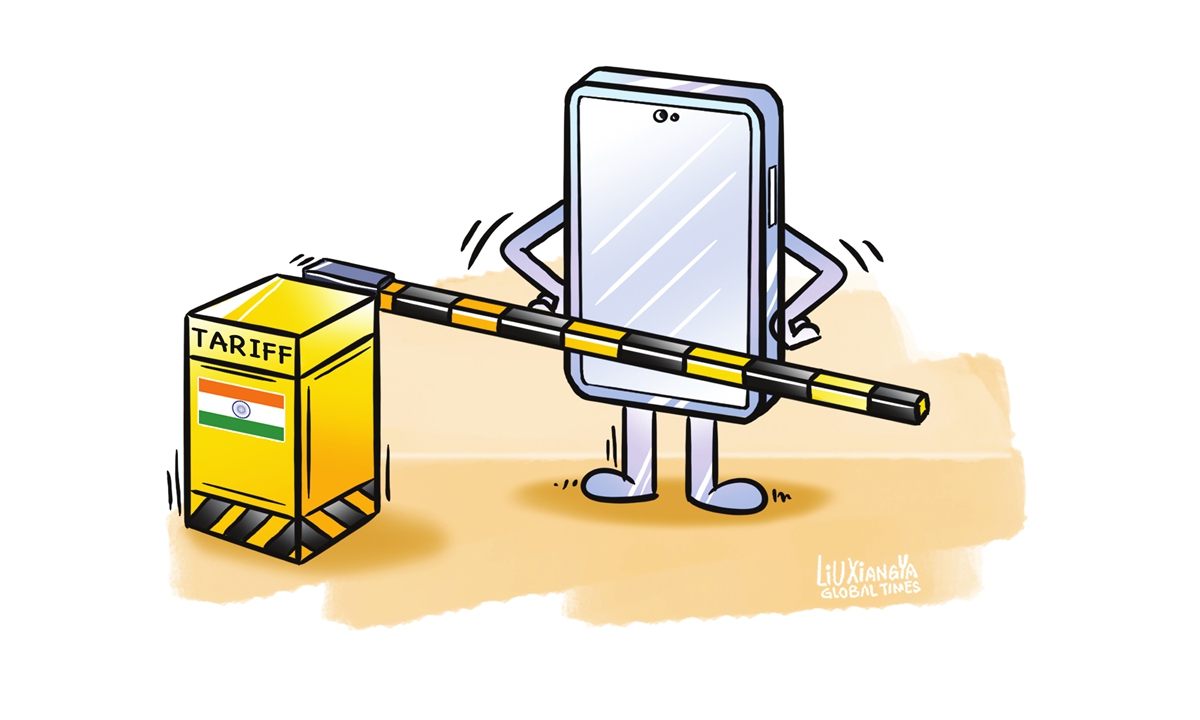
Illustration: Liu Xiangya/Global Times
India cut the import duty on a number of mobile phone components to 10 percent from 15 percent, which has brought much-needed good news to the country's mobile phone manufacturing sector. Yet it is not enough.
The government needs to take further and more vigorous policy measures according to changes in supply chains to promote the manufacturing sector, and try everything it can to make sure that multinational enterprises, including Chinese manufacturers, receive fair treatment in the country.
Many people in India seem to be optimistic about the future of the country's mobile phone sector, because there has been exponential growth.
Some Indian media outlets claim the country has become the world's second-largest producer of mobile phones after China, as locally made mobile phone shipments crossed the 2 billion cumulative mark in the 2014-2022 period, registering a 23 percent compound annual growth rate.
This won broad applause, but to be frank, there is still a long way for India to go to make itself into a mobile phone manufacturing powerhouse. Major obstacles remain for India to attract international mobile phone manufacturers to set up factories in the country for production.
First, high tariff rates have led to increased production costs for manufacturers. According to Indian media outlets, the India Cellular & Electronics Association recently released a study on tariffs on components and sub-assemblies for making smartphones, which found that India has the highest tariffs among six manufacturing competitors.
Without enough local industrial chain support, India relies heavily on imported components to assemble mobile phones. Although India has cut the import duty by 5 percentage points, it's not enough to solve its high tariff problem.
Second, arbitrary suppression of Chinese companies by India has resulted in a loss of confidence among Chinese investors. Some statistics showed Chinese phone producers represented more than half of the global top 10 in smartphones. India cannot replace the role of China in global supply chains. Only cooperation can bring a bright future.
Third, India has the reputation of being a foot-dragger when it comes to free trade agreements (FTAs). The low participation in FTAs makes it difficult for India to turn itself into an export hub. With the increase in domestic manufacturing, India's mobile exports have been rising, but its growth may face a bottleneck.
As reported by Indian news agency last year, the Indian government aims to achieve $300 billion worth of electronics manufacturing by 2025-26, with mobile phones contributing more than $50 billion in exports. It is an ambitious goal for India's mobile phone industry, which reportedly surpassed $10 billion worth of smartphone exports in fiscal 2022-2023.
The newly announced duty cut can help strengthen the mobile phone manufacturing ecosystem and improve India's export competitiveness in the industry, but this may not be enough to enable India to meet its ambitious goals. The country needs to roll out more stimulus measures to support its mobile phone sector.
Hopefully India can further cut import duties and proactively integrate into regional industry and value chains. In particular, India should stop suppressing Chinese smartphone companies after benefiting from their capital and technology. At the very least, India must provide a fair, unbiased and non-discriminatory business environment for foreign companies, including Chinese ones.
India's electronics exports have surged, fuelled by the mobile phone boom, but the country cannot rely solely on individual industries to drive manufacturing growth. India should seek more growth opportunities beyond mobile phones. In this context, the duty cut should be expanded from the mobile phone sector to more industries.
The author is a reporter with the Global Times. bizopinion@globaltimes.com.cn




